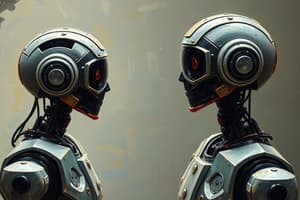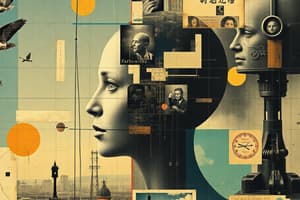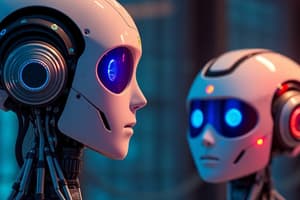Podcast
Questions and Answers
What is the definition of an agent?
What is the definition of an agent?
An agent is an entity that perceives and acts in an environment.
Which of the following is NOT an example of a software agent?
Which of the following is NOT an example of a software agent?
- Human (correct)
- Crawler
- Webbot
- Email agent
The concept of a "single agent" is more prevalent than that of "multi-agents" in distributed AI.
The concept of a "single agent" is more prevalent than that of "multi-agents" in distributed AI.
False (B)
What are the two primary components through which agents interact with their environments?
What are the two primary components through which agents interact with their environments?
What is the function of a sensor?
What is the function of a sensor?
Which of the following is NOT an example of an actuator in an automated taxi?
Which of the following is NOT an example of an actuator in an automated taxi?
What are the four possible actions that a vacuum cleaner agent can take in the "Vacuum-cleaner world" scenario?
What are the four possible actions that a vacuum cleaner agent can take in the "Vacuum-cleaner world" scenario?
What concept describes the complete specification of an agent, mapping from percept histories to actions?
What concept describes the complete specification of an agent, mapping from percept histories to actions?
The goal of the agent function is to produce the agent program.
The goal of the agent function is to produce the agent program.
What are the two primary components that make up an agent program?
What are the two primary components that make up an agent program?
An agent program processes a sequence of percepts as input.
An agent program processes a sequence of percepts as input.
What does "persistent" mean in the context of the "SKELETON-AGENT" algorithm?
What does "persistent" mean in the context of the "SKELETON-AGENT" algorithm?
What is an algorithm?
What is an algorithm?
Which of the following is NOT a valid form of pseudocode?
Which of the following is NOT a valid form of pseudocode?
Pseudocode is a highly formal language that requires strict syntax and structures.
Pseudocode is a highly formal language that requires strict syntax and structures.
What is the significance of indentation in pseudocode?
What is the significance of indentation in pseudocode?
Explain the concept of "Destructuring assignment" in pseudocode.
Explain the concept of "Destructuring assignment" in pseudocode.
In pseudocode, "while c (condition) do" means the condition is evaluated after each iteration of the loop.
In pseudocode, "while c (condition) do" means the condition is evaluated after each iteration of the loop.
What is a generator in pseudocode?
What is a generator in pseudocode?
What are the four directories that the code for agent projects is typically divided into?
What are the four directories that the code for agent projects is typically divided into?
It is generally recommended to run algorithms on domains rather than agents in environments.
It is generally recommended to run algorithms on domains rather than agents in environments.
The "Table_Driven_Vacuum_Agent" function takes a table as input, but it does not require a percept sequence.
The "Table_Driven_Vacuum_Agent" function takes a table as input, but it does not require a percept sequence.
The table in the "Table_Driven_Vacuum_Agent" function is represented as a list of key-value pairs, where each pair contains a percept sequence and a corresponding action.
The table in the "Table_Driven_Vacuum_Agent" function is represented as a list of key-value pairs, where each pair contains a percept sequence and a corresponding action.
What is the definition of an environment in the context of AI agents?
What is the definition of an environment in the context of AI agents?
An environment is considered "feministic" due to its non-interactive nature.
An environment is considered "feministic" due to its non-interactive nature.
Which of the following scenarios is an example of a fully observable environment for an agent?
Which of the following scenarios is an example of a fully observable environment for an agent?
A deterministic environment can be completely controlled by an agent, whereas stochastic environments are often unpredictable.
A deterministic environment can be completely controlled by an agent, whereas stochastic environments are often unpredictable.
In the context of environment features, what is the distinction between episodic and sequential environments?
In the context of environment features, what is the distinction between episodic and sequential environments?
Multi-agent environments are generally simpler to design and analyze compared to single-agent environments.
Multi-agent environments are generally simpler to design and analyze compared to single-agent environments.
Describe the concept of a "dynamic" environment.
Describe the concept of a "dynamic" environment.
A chess game is an example of a continuous environment.
A chess game is an example of a continuous environment.
Known environments imply that the results of all actions are predictable and understood by the agent.
Known environments imply that the results of all actions are predictable and understood by the agent.
What is the definition of a rational agent?
What is the definition of a rational agent?
Perfect rationality is achievable in real-world scenarios with limited computational resources.
Perfect rationality is achievable in real-world scenarios with limited computational resources.
Rational agents are always able to make accurate predictions about the outcomes of their actions.
Rational agents are always able to make accurate predictions about the outcomes of their actions.
What are some of the key aspects of limited rationality that agents need to consider?
What are some of the key aspects of limited rationality that agents need to consider?
The concept of "PEAS" stands for Performance, Environment, Actions, and Sensors, and it is a framework used to design rational agents.
The concept of "PEAS" stands for Performance, Environment, Actions, and Sensors, and it is a framework used to design rational agents.
In the automated taxi agent example, the agent's sensors include items like steering, accelerator, and brakes.
In the automated taxi agent example, the agent's sensors include items like steering, accelerator, and brakes.
In the context of multi-agent systems (MAS), what is the defining characteristic of coordination?
In the context of multi-agent systems (MAS), what is the defining characteristic of coordination?
A faulty agent in MAS can potentially disrupt the entire system by spreading its failures to other connected agents.
A faulty agent in MAS can potentially disrupt the entire system by spreading its failures to other connected agents.
What is the primary goal of task allocation in MAS?
What is the primary goal of task allocation in MAS?
In MAS, agents typically have a global view of the entire system, allowing them to make decisions based on complete information.
In MAS, agents typically have a global view of the entire system, allowing them to make decisions based on complete information.
Which of the following is NOT a common organization strategy for agents in MAS?
Which of the following is NOT a common organization strategy for agents in MAS?
The "Congregation" organization strategy in MAS focuses on agents collaborating to achieve common goals that they cannot accomplish independently.
The "Congregation" organization strategy in MAS focuses on agents collaborating to achieve common goals that they cannot accomplish independently.
Agent projects typically involve designing and implementing complex agents with extensive functionality.
Agent projects typically involve designing and implementing complex agents with extensive functionality.
Agent projects generally require advanced programming skills and knowledge of complex AI algorithms.
Agent projects generally require advanced programming skills and knowledge of complex AI algorithms.
Which of these options represents a type of Internet agent?
Which of these options represents a type of Internet agent?
Flashcards
Agent
Agent
An entity that interacts with its environment by perceiving and acting.
Agent Program
Agent Program
A program that enables the Agent to function by mapping percept histories to actions.
Rationality
Rationality
The ability of an agent to choose actions that maximize its desired outcome based on its current knowledge and environment.
Environment
Environment
Signup and view all the flashcards
Agent Structures
Agent Structures
Signup and view all the flashcards
Multi-agent Systems (MAS)
Multi-agent Systems (MAS)
Signup and view all the flashcards
Simple Reflex Agents
Simple Reflex Agents
Signup and view all the flashcards
Model-based Reflex Agents
Model-based Reflex Agents
Signup and view all the flashcards
Goal-based Agents
Goal-based Agents
Signup and view all the flashcards
Utility-based Agents
Utility-based Agents
Signup and view all the flashcards
Learning Agents
Learning Agents
Signup and view all the flashcards
Performance Measure
Performance Measure
Signup and view all the flashcards
Limited Rationality
Limited Rationality
Signup and view all the flashcards
PEAS (Performance/Environment/Actuators/Sensors)
PEAS (Performance/Environment/Actuators/Sensors)
Signup and view all the flashcards
Fully Observable
Fully Observable
Signup and view all the flashcards
Deterministic
Deterministic
Signup and view all the flashcards
Episodic
Episodic
Signup and view all the flashcards
Dynamic
Dynamic
Signup and view all the flashcards
Continuous
Continuous
Signup and view all the flashcards
Multi-agent
Multi-agent
Signup and view all the flashcards
Coordination
Coordination
Signup and view all the flashcards
Communication
Communication
Signup and view all the flashcards
Fault Detection and Isolation (FDI)
Fault Detection and Isolation (FDI)
Signup and view all the flashcards
Task Allocation
Task Allocation
Signup and view all the flashcards
Localization
Localization
Signup and view all the flashcards
Agent Organization
Agent Organization
Signup and view all the flashcards
Flat Agent Organization
Flat Agent Organization
Signup and view all the flashcards
Hierarchical Agent Organization
Hierarchical Agent Organization
Signup and view all the flashcards
Coalition Agent Organization
Coalition Agent Organization
Signup and view all the flashcards
Congregation Agent Organization
Congregation Agent Organization
Signup and view all the flashcards
Agent Project
Agent Project
Signup and view all the flashcards
Study Notes
Intelligent Agents
- Intelligent agents are entities that perceive and act within an environment.
- Agents can encompass animals, humans, robots, software agents (softbots), internet agents (crawlers, webbots, email agents, search agents, chatbots), and more. Examples include Cortana, Siri, Google Assistant, Watson, Alexa, and others.
- Agents can be single or multi-agent (distributed AI).
- Agents operate through sensors that perceive aspects of the environment, and actuators that affect the environment.
- Perception involves interpreting sensor responses to gain information about the world where the agent exists.
- Actuators include hands, legs, vocal tracts, and mechanized equivalents such as accelerator, steering, and braking mechanisms.
Agents and Environments
- Agents perceive their surroundings through sensors.
- Sensors provide input in various forms – vision, hearing, touch, radio, infrared, GPS, wireless signals, and active sensing (sending out signals that reflect and are perceived to determine an object's characteristics).
- Agents act on their environment utilizing actuators.
- An example is a robot vacuum cleaner, where percepts relate to the position and state (e.g., clean or dirty) of each portion of the floor. Actions may be "Left", "Right", "Suck" or "NoOp."
Sensors and Actuators
- Sensors measure environmental features.
- The IoT (Internet of Things) encompasses environmental data sources.
- Perception is the processing of sensor data to extract information.
- Actuators trigger actions within the environment, and are exemplified by hands, legs and vocal mechanisms, and their equivalents in automated systems (e.g., accelerators, steering, braking).
Example: Vacuum-cleaner world
- A robot vacuum, e.g., iRobot Roomba, is an agent that navigates a room and maintains it clean.
- The room's features are perceived by the robot.
- Actions include moving, and cleaning (suctioning).
Agent Functions
- Agent functions specify the actions an agent takes based on its perceptions.
- An agent's behavior is entirely defined by its function, which maps past perceptions to actions.
- For any given environment, ideal agents provide optimal performance.
- Implementing the ideal function concisely remains a challenge. Rational agents act to maximize the expected value of the performance measure given the perceived sequence up to that time.
Example: A vacuum-cleaner agent
- An agent analyzes perception to choose an action based on a table of states and actions.
- Table-driven agent receives a percept, adds it to a sequence, and looks up the resulting action in a table.
Agent Programs
- Agent programs execute on a physical architecture.
- An agent's program and architecture constitute the agent function.
- The program takes input from sensors, keeps an internal state (often in memory), and produces output for actuators.
- A skeleton agent is a basic agent function template, which includes steps for updating memory and choosing the best action according to memory.
Other forms of algorithms
- Pseudocode is a simplified, informal way to represent algorithms.
- It uses programming-like syntax and natural language.
- It helps in designing algorithms before implementing them in a specific programming language.
Algorithm
- An algorithm is a detailed set of instructions for solving a problem.
- Algorithms can be applied to many types of problems.
- Time and space complexity analyze how algorithms perform.
The pseudocode
- The pseudocode is a concise way to represent algorithms.
- Variables have italicized lowercase names.
- Functions are named using capitalized letters.
- Pseudocode may use mathematical formulas or English to describe elements.
- Conditional statements (e.g., "if...then...else") and loops (e.g., "for each" and "while") have significant indentation.
- It supports assignment (e.g., "x ← value"), de-structuring assignment (e.g., "x, y ← pair"), loops (e.g., "for each x in c do"), and generators that produce a sequence of values.
The code
- Algorithms in pseudocode can be implemented in a variety of programming languages, such as Python, Java, C/C++, Lisp, and Prolog.
- These implementations will typically involve specific code for agents, algorithms, environments, and domains.
A Python coding
- Python is a common language for implementing agent programs.
- The code structure usually consists of separate directories for agents, algorithms, environments, domains.
Example: A vacuum-cleaner agent (Python)
- A table-driven approach can implement the agent, using a dictionary style table to map percept sequences to actions.
Agent Environment in AI
- An environment is everything surrounding an agent, but excluding the agent itself.
- Environments provide agents stimuli for sensing and reacting.
- Environments can be characterized as static or dynamic, and observable or non-observable.
Features of Environment
- Environments can have diverse characteristics, from fully observable to partially observable, static to dynamic, discrete to continuous, deterministic to stochastic, single agent or multi-agent, episodic or sequential, known and or unknown, and accessible or inaccessible.
Rationality
- Rational agents aim for optimal performance.
- Goals dictate desirable outcomes, which are measurable in terms of a numerical performance measure, and adaptable to changing circumstances through exploration, learning, and autonomy.
Example: Vacuum-cleaner rational agent.
- Performance measures for vacuum robots could include points for cleaned squares, penalties per move, or for remaining dirty squares.
PEAS (Performance/Environment/Actuators/Sensors)
- To design a rational agent, PEAS specifies its performance measure, environment, actuators, and sensors (e.g., for an automated taxi: performance metrics include legality, safety, profitability, with the environment consisting of roads, vehicles and pedestrians, having actuators like steering. brake, accelerator, and sensors like GPS, cameras, etc.).
Example: Automated taxi agent
- Performance measures include safety, profit, schedule adherence.
- Environment factors include road conditions, traffic flow, pedestrians, and weather.
- Actuators include accelerator, braking mechanisms, steering, and communication devices.
- Sensors such as cameras, GPS trackers and other traffic and sensor systems will furnish the necessary information and data.
Example: Internet shopping agent
- Performance measures include efficiency, price, appropriateness.
- The environment comprises websites, vendors, and delivery services.
- Actuators include user interaction mechanisms and data processing.
- Sensors capture text, graphics, data and other data from websites to complete transactions.
Environments
- Features of different environments (e.g., Solitaire, Backgammon, Internet shopping, and Taxi) are detailed.
Agent Structures
- Different agent structures exist (simple reflex, model-based reflex, goal-based, and utility-based).
- These can be augmented by learning to become more effective.
Multi-agent systems (MAS)
- Multi-agent systems (MAS) are composed of multiple agents interacting amongst neighbours.
- Tasks are often divided into smaller tasks and assigned to specific agents.
Properties of Multi-Agent Systems (MAS)
- MAS properties include coordination, communication (agents interacting), fault detection and isolation (FDI), task allocation (distributing tasks), and localization (restricting an agent's view).
Agent Organization
- Methods for agent communication and structure within a MAS include flat (all equal), hierarchical, holons (grouped by characteristics), coalition (temporarily grouped by goals), team, matrix, and congregation (groups operating locally).
The agent projects
- Projects involve designing and implementing agents utilizing new knowledge (e.g., internet agents, intelligent robots).
- Programming languages and environments (such as those with which the students are already familiar) will be appropriate.
- Projects may involve single or multiple agents.
Studying That Suits You
Use AI to generate personalized quizzes and flashcards to suit your learning preferences.




